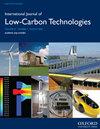Improving thermal performance of a ventilated tiled roof by using phase change materials
IF 2.3
4区 工程技术
Q3 ENERGY & FUELS
引用次数: 0
Abstract
The adoption of ventilated roofs and facades, as well as the integration of phase change materials (PCMs) in the building envelope, have proved to be effective as passive cooling techniques in reducing the solar heat gain through the building envelope during the summer period and, therefore, reduce the energy requirement for cooling. Even though much research focused on each of these strategies individually, their combination has not been deeply studied yet. Preliminary numerical studies were carried out on the application of PCMs on a pitched ventilated tiled roof and the most effective position turned out to be suspended in the middle of the above sheathing ventilation (ASV) channel. Based on this conclusion and exploiting an existing mock-up facility, two equivalent pitched ventilated roofs with an air gap of 4 cm were built as coverage of two identical rooms, each one equipped with a fan coil, one with a 0.007 m PCM layer suspended in the middle of the ASV and the other one without. They were then tested under real conditions at the TekneHub Laboratory at the University of Ferrara. The behaviour of the two configurations were compared in terms of temperature, velocity of the air in the ASV, heat flux, and energy requirement for cooling, which were monitored through T-type thermocouples, heat flow meter, anemometers and energy meters, respectively. The aim of the research was to validate the numerical results and confirm that the combination of the two strategies allows further improvement of roof performance.采用相变材料改善通风瓦屋顶的热工性能
事实证明,采用通风屋顶和立面,以及在建筑围护结构中集成相变材料(PCM),作为被动冷却技术,可以有效减少夏季通过建筑围护结构获得的太阳能热量,从而降低冷却所需的能源。尽管许多研究都集中在每一种策略上,但它们的组合还没有得到深入研究。对PCM在倾斜通风瓦屋顶上的应用进行了初步的数值研究,结果表明,最有效的位置是悬挂在上述盖板通风(ASV)通道的中间。基于这一结论,并利用现有的实体模型设施,建造了两个等效的倾斜通风屋顶,气隙为4厘米,覆盖两个相同的房间,每个房间都配备了风机盘管,一个带有0.007米的PCM层,悬挂在ASV中间,另一个没有。然后在费拉拉大学的TekneHub实验室对它们进行了真实条件下的测试。通过T型热电偶、热流计、风速计和能量计分别监测了两种配置在ASV中的温度、空气速度、热通量和冷却能量需求方面的行为。研究的目的是验证数值结果,并确认两种策略的结合可以进一步提高屋顶性能。
本文章由计算机程序翻译,如有差异,请以英文原文为准。
求助全文
约1分钟内获得全文
求助全文
来源期刊

International Journal of Low-carbon Technologies
Engineering-Architecture
CiteScore
4.30
自引率
4.30%
发文量
106
审稿时长
27 weeks
期刊介绍:
The International Journal of Low-Carbon Technologies is a quarterly publication concerned with the challenge of climate change and its effects on the built environment and sustainability. The Journal publishes original, quality research papers on issues of climate change, sustainable development and the built environment related to architecture, building services engineering, civil engineering, building engineering, urban design and other disciplines. It features in-depth articles, technical notes, review papers, book reviews and special issues devoted to international conferences. The journal encourages submissions related to interdisciplinary research in the built environment. The journal is available in paper and electronic formats. All articles are peer-reviewed by leading experts in the field.
 求助内容:
求助内容: 应助结果提醒方式:
应助结果提醒方式:


